Tameshigiri Unveiled: Complete Guide to the Art of Japanese Sword Testing

What’s in this article?
Tameshigiri is the modern Japanese art of sword target cut practice. It is a tradition rooted in Japanese history used to test the might, endurance, and toughness of a traditional Japanese sword called nihonto. The tameshigiri targets have changed over time, but the art in itself is still very much alive.
This article will delve into the world of the tameshigiri art. First, we will explain what it means today and how it differs from history. Then, we will explain the materials that can be used for modern tameshigiri practice targets, as well as the different types of cuts that exist. Ultimately, we will give you the basics to help start your tameshigiri adventure.
What is Tameshigiri?
Tameshigiri is the art used to test the might of a traditionally made samurai sword as well as the swordsmanship skills of its user. The katana is the most common sword used for tameshigiri test cutting. It is a cutting practice target commonly present in almost every kensei dojo and many different Japanese sword martial arts such as kendo.
The tameshigiri can be made of many materials, but the most common today are tatami omote mats, sometimes known as goza. This sword-cutting target can be placed vertically, diagonally, or horizontally and cut with a single, double, triple, or more consecutive cuts.
Tameshigiri targets are useful for many different purposes. They can be used to test the quality of the sword, which will then be evaluated and ranked by Japanese judges trained in the art of samurai swords. Tameshigiri is useful for beginners training their blade-edge alignment as well as for veterans to hone the skills of their cutting ability. It is also used to test and rank the katana stances known as kamae or the different kata strikes in historical sword manuals.
Tameshigiri was not a style used to train the samurai but instead translates to “test-cutting.” While today it is a training tool for a swordsman, it had different and even gruesome purposes throughout history.
Types of Tameshigiri
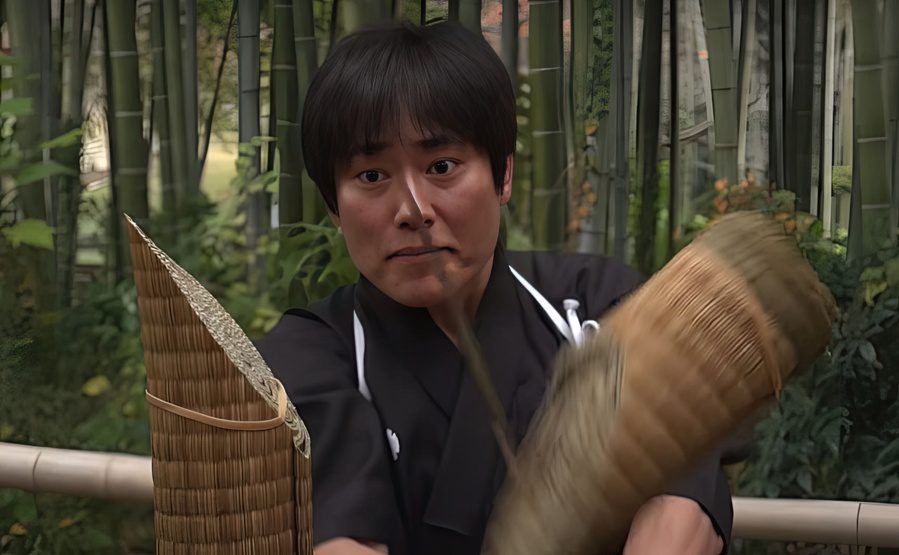
Tameshigiri is a Japanese budo or martial art focusing on cutting target practice. The tameshigiri was only used for one purpose in history?testing the quality of a blade that can be used for sword fighting. Today, it is used to test the user’s ability as well. These factors split the Japanese tameshigiri art into shito and shizan?sword testing and test cutting.
Shito-No-Tameshigiri?Testing the Sword’s Quality
This style of tameshigiri was widely used throughout history to determine the level of quality behind a sword made by a Japanese swordsmith. The shito can be split into two basic elements, which were reviewed by judges in the past.
- Sharpness – testing just how powerful and sharp a blade can be as well as the damage it can inflict on its target
- Durability – determining that a sword is still flexible and durable after abusive cutting tests on various materials
The results achieved by certain swords made them superior and were often marked on the very same blade, which could raise their price tag and value for samurai to use them.
Shizan-No-Tameshigiri?Testing the Swordsman’s Skill
The shizan type of tameshigiri is the current and contemporary Japanese sword test-cutting art. Judges rank the number of true cuts performed on a target and the quality of the cuts based on many factors such as speed or amount of tatami rolled mats. The challenges faced by the person performing the test?especially when working with materials of varying densities like bamboo, wood, or rolled-up tatami mats?can elevate their status as a swordsman.
The density of these materials is approximately the same as human flesh or bone. The judges test the user based on the traditional shidzan-no-kokoroe-jukaze, which are ten essential rules that a tameshigiri practitioner must follow. These include the quality of the cut, the right posture, and kamae stance, unsheathing and sheathing the blade.
One of the highest and most difficult tests to determine a true tameshigiri expert is the senbongiri cut, which cuts one thousand targets. Aaron Mccloud currently holds the record, completing the 1000 cuts in 33 minutes and 34 seconds. Isoo Machii holds second place with a time of 36 minutes and 4 seconds.
History of Tameshigiri
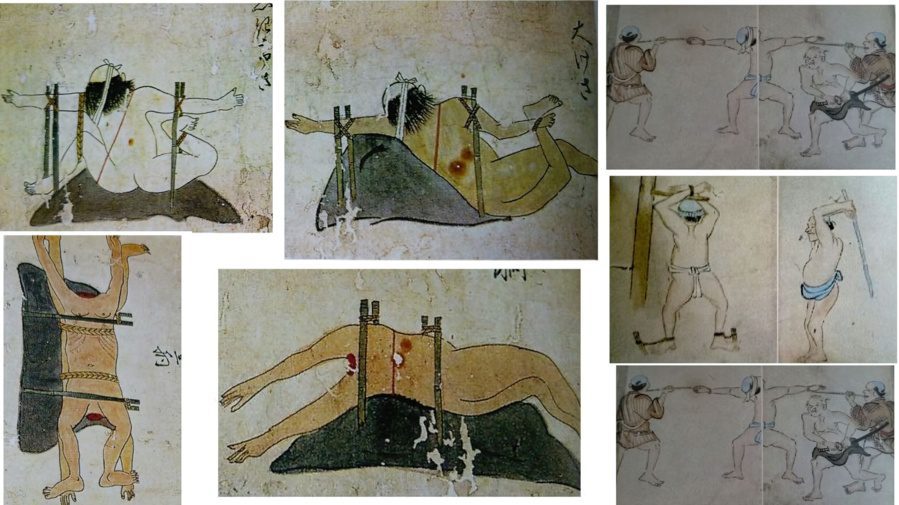
Tameshigiri was founded during Japan’s Edo Period (1603-1867) not as a martial art but as a test-cutting practice. It came as a need for Japanese swordsmiths and warriors to test the power of their newly created swords since this peaceful era of Japanese history was one of internal stability. Test cutting was crucial, and professionals or samurai were often asked to test their katanas on various targets.
Tameshigiri targets were rolled-up rice straws known as wara, bamboo sticks, thin layers of steel, and even samurai armor. However, the ideal target to test the might and power of a katana’s blade against a human being was human. Tameshigiri human targets ranged from slaves and criminals to corpses to poor burakumin people who were once strapped without rights.
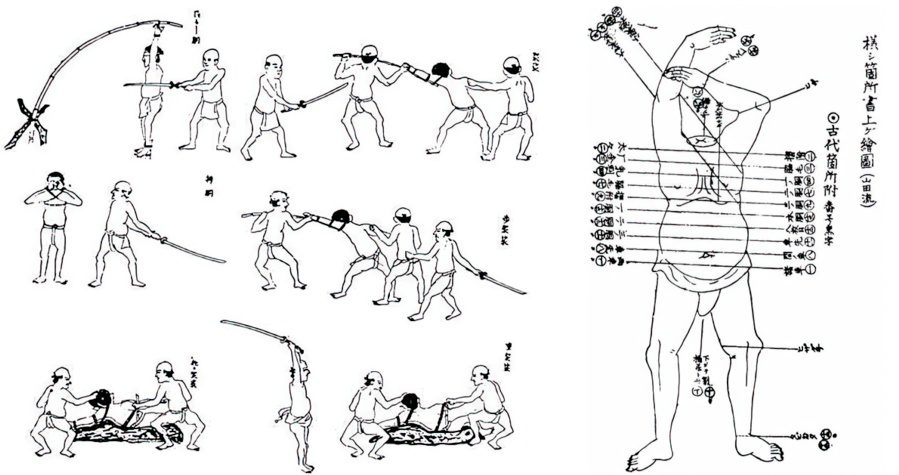
Highly professional sword tameshigiri users were chosen to ensure the swords’ best accuracy and blade power. There were many different strikes, such as decapitation and dismemberment, cutting a person in half with a single slash, and other cuts that were ranked in difficulty, such as whether or not the person was in a hanging position. The result of tameshigiri human cutting was inscribed on the nakago blade’s tang, known as tameshi-mei or saidan-mei.
The more injuries the katana inflicted, including those performed with great difficulty, reflected value and profit for its sword-maker. The record for most human cuts in half with a Katana is 7.
Traditional to Modern Tameshigiri

The traditional tameshigiri sword testing was banned during the Meiji era (1868-1912), but it was still carried out again during World War II on civilians. The tameshigiri martial art, as we have it today, was established towards the war’s end. With the short ban on katana swords in Japan, Japanese people saw this traditional sword being lost as a part of their culture and the swords becoming just a formality.
To avoid further human injury, different tameshigiri targets were made. The first were bundled straws and bamboo targets, but they were inconvenient. Rolled-up tatami mats soaked in water for several days soon proved efficient and became the new tameshigiri cutting test targets and are still used today.
Today, tameshigiri is not used for testing the sword’s power as it was throughout history; it has instead become a way of determining the tester’s or practitioner’s cutting ability.
Different Types of Modern Tameshigiri Cuts
The cutting on a tameshigiri target, most popularly on a tatami mat, can be split into three categories. The categories and levels are determined by various factors. This could be the slash type (from a simple diagonal cut to double or triple consecutive cuts at a time), the kamae stance before executing a cut, or the pause or time spent after or between the cuts.
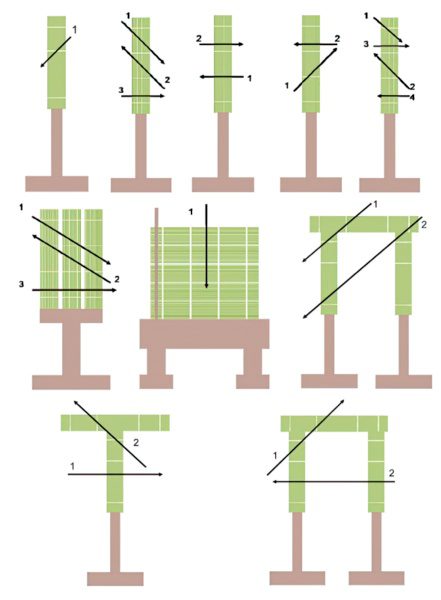
Another factor is the pattern taken in a slash, whether diagonal or horizontal. Some slashes can be vertical, but they are primarily for testing the might and durability of a sword and on more stacked tatami mats on top of each other.
The following are the levels of difficulty:
- Beginner: sayuw kesa giri, gyaku kesa giri, godan giri, rokudan giri
- Intermediate: futo giri, yoko-narabi, inazuma-giri, tsubame gaeshi, dodan, gyaku-inazuma giri, nami gaeshi
- Advanced: dow barai, daruma otoshi, kasumi, makuri, kawasemi, mizu guruma, mizu gaeshi, nuki uchi, tombo, syo hatto, zengo-no-teki
The difficulty behind a type of cut is also determined by the material’s hardness and the direction of the grain inside the tatami mat. It is also determined by the sword’s quality, hardness, cutting edge, and, most importantly, the blade edge angle alignment.
Most of these cutting slashes draw inspiration from previously done cutting slashes on cadavers, some of which are the tabi-gata and o-kesa?the ankle cut and the shoulder to the opposite hip cut.
Modern Popular Tameshigiri Tatami Materials
The most common tameshigiri target practice materials today are the tatami mats. The modern tatami omote is believed to have originated from the modern Japanese sword master Toshihiro Obata of the Shinkendo School.
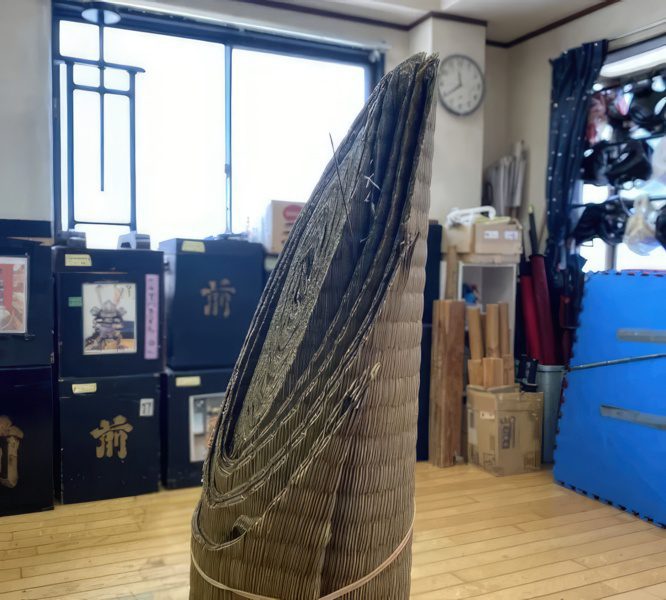
Each tatami mat is tightly rolled and bound by strings at different intervals. Once wrapped in a long shape, they are soaked in water for up to 24 hours before use. Roughly 30 minutes before being used, the tamashigiri tatami mat is drained of water to be used for effective cutting.
The tameshigiri omote tatami mat has approximately the same consistency and thickness as a human muscle, often with bamboo through the middle to resemble the density of a human neck.
Other materials can be used as well, such as:
- Beach Mats – a lighter target that does not have much resistance, making them easy for beginners
- Bamboo – there is a large variety with a wide range of thicknesses that will test the power and blade-edge alignment of the user
- Hardwood Dowels – stronger consistency than bamboo, requiring more experience. Dowels can easily lead to a dented blade with a badly aligned blade cut
The Art and Styles of Tameshigiri

Despite the belief of some, honing the skills of a samurai sword isn’t only connected to certain hard targets such as tatami mats. There are several kinds, based on the material used and the difficulty of delivering a clean cut-through, known as hasuji.
It is important to note that Iai strike methods, such as using an iaido sword, should be the core. Simply cutting through things isn’t considered tameshigiri art. Certain methods and even batto, the art of drawing the katana sword, should be followed, accompanied by stances and breaks between the cuts.
Here are some of the traditional styles of tameshigiri in practice:
- Mizugiri – the art of cutting through standing water without causing a splash
- Waragiri – cutting through stacked rolls of straw mats between two to eight inches (15 to 21 cm ) thick. Depending on the ryuha school of thought, the straw can be replaced with bamboo, wood, or standing trees
- Usumonigiri – cutting through a very thin and light paper-like material placed on wood with the intent to cut it without damaging or scratching the wood
When a swordsman is cutting in the different styles of tameshigiri, there are rules that should be followed. These consist of a true grip, posture and balance, right cut angle, timing coordination, swing arc, distance, balance and weight shift, swing stop and shake, and blade swing rotations.
Tameshigiri Basics and Benefits
Many cutting practice targets can be used for honing your sword skills today. The tameshigiri tatami mat is easily among the sword community’s most favored. The premise is to get a tameshigiri “clean-cut,” which can require months and even years of training.
No matter the ryuha Japanese sword school, one might be a student, tameshigiri should be practiced by all kenshi sword enthusiasts. Here are some of the biggest benefits of practicing the art of tameshigiri.
- Blade edge and angle alignment (hasuji)
- Timing (ritsudo)
- Distance (kirima)
- Grip (tenouchi)
More consecutive cuts can be achieved with practice, and different types can be easily achieved. Here are some basics to consider when starting in tameshigiri cutting practice by using a katana sword.
- Hold the tsuka handle with your right hand under the tsuba handguard (up), and the left hand being two fingers lower worth of distance (down)
- Maintain a kamae stance with the right foot in front with bent knees while stretching out your arms in front of you with the blade’s tip centered at your chest
- Raise your hands high above your head and shift the katana on the right side above your right ear
- Swing the katana down the side of your left waist as you draw a diagonal line starting above your head
- Helpful Tip: Imagine you are casting a fishing line into water, as this is the same motion.




